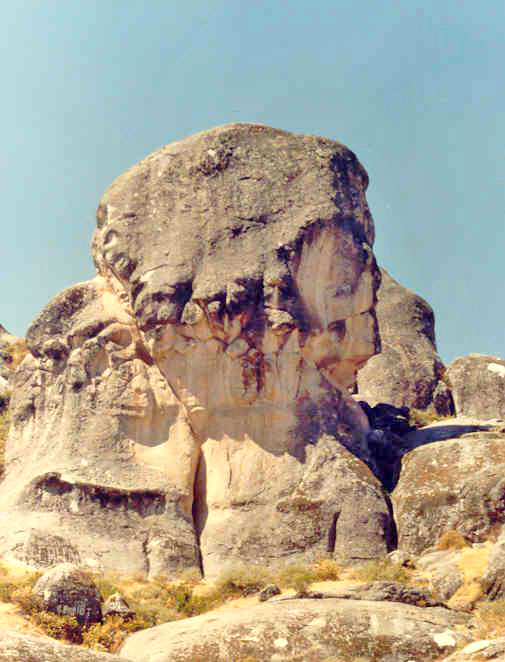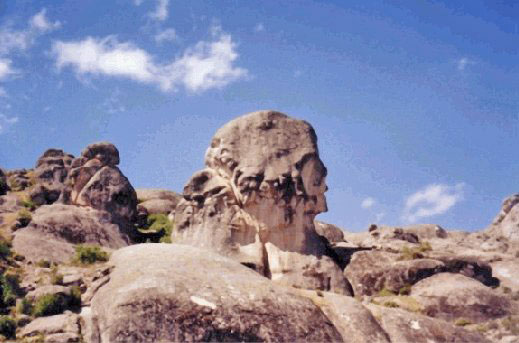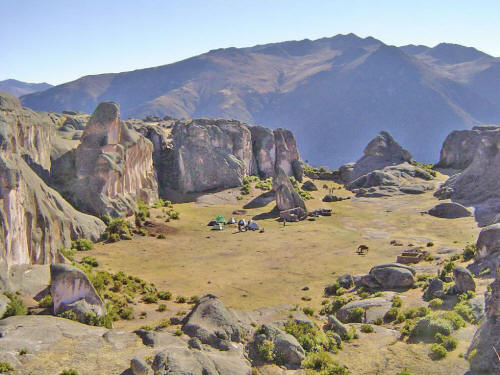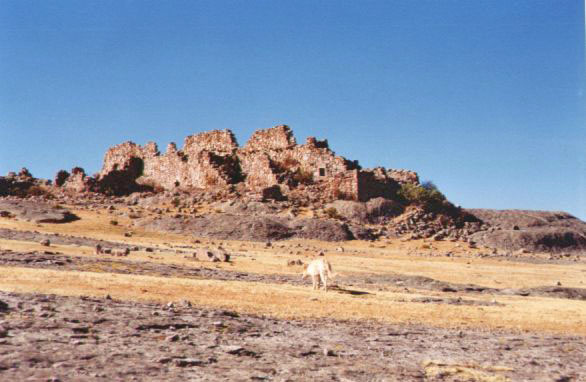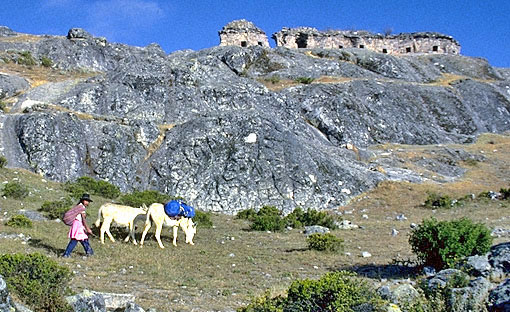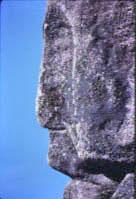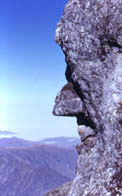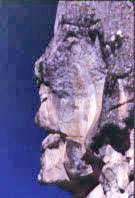|
|
|
from UnicusMagazine Website recovered though WayBackMachine Website
These are the words of
Daniel Ruzo, found in the introduction of his book, "Marcahuasi The
Story of a Fantastic Discovery", first published in the Spanish
language in 1974. Ruzo (1900-1993) was certainly one of the
grandfathers of the New Age.
The "monuments repeating the same symbols" are found in Tepotzlan and Guanajuato, Mexico; Rio de Janeiro and Vila Velha in Brazil; Lake Titicaca, San Cristobal and Los Angeles in Peru; Stonehenge and Avebury in England; The Sacred Valley of the Kings in Egypt; the Carpatos mountains in Rumania; and Kakadu National Park in Australia to name a few.
Although Daniel Ruzo also studied the monuments of the
Easter
Islands, he made no conclusion about their origin. All of the
monuments in all of these places, according to Ruzo, were created by
a humanity that lived before the time of the flood for which Noah
built his arc.
According to Ruzo the catastrophe (a fire, previous to the flood) was survived by
Adam and Eve by living deep inside caverns.
The theory is:
According to Ruzo the next catastrophe will be by air and will occur
between the years 2127 and 2137.
As the monuments are only indicators that these all-important entrances are in the general area, we, the faithful, must make it our mission to locate the entrances, in time to prepare the caves and caverns, before the next catastrophe and save the seeds of humanity as they have been saved by the previous humanities.
The universal symbols referred to in the introduction of
"Marcahuasi" are the key to understanding how to locate the
entrances on the sacred mountains. As the entrances have yet to be
found, we must work to "break the code" of the symbols to find them.
The main monument, the Monument of Humanity, has fourteen faces visible by the light of the sun and two visible only by the light of the moon. Ruzo’s photos demonstrate very clearly the many different faces of Marcahuasi. He claims that even though his work went on for a lengthy nine years that he has studied a mere ten percent of the figures.
Other important monuments rare the Condor, whose form changes every sixty degrees, and the Feline which can be seen only during the week of the winter solstice.
There are many other important facets of Marcahuasi, all pieces of an incredible, complex puzzle. There are twenty-two energy vortexes called "cruzes" or crosses, made up of three distinct types of energy.
Carlos Seclan, a Peruvian disciple of Daniel Ruzo, had an extraordinary experience at one of the vortexes of Marcahuasi.
He
had been studying Marcahuasi for fifteen years when he had a car
accident, which left him paralyzed, in bed, for eleven months. With
the finest doctors in Peru available to treat him, he was told that
he could not be healed and would never walk or even sit up again.
As he
moved, he felt a heat rising through his body starting at his toes.
He heard a distinct buzzing noise and felt a tingling at the same
time. When the heat and buzzing sensations reached the top of his
head, about twenty minutes later, he felt as though a light entered
the top of his head.
The man was gone, and Carlos walked down the mountain alone to join his friends who had been waiting for him at the cabana, the house that Daniel Ruzo built behind the Monument of Humanity.
Carlos is the most important scholar of the vortexes of Marcahuasi.
He only shows five of the vortexes to others. Two of the vortexes
are easy to find on the plateau: one is located beneath the Feline,
and the other, marked with a white X, is in the center of the
plateau, at the edge of a precipice. Carlos first went to Marcahuasi
in 1973, on a hunting trip. He says that before he went, he had seen Marcahuasi in his dreams, and when he arrived, he knew exactly where
to go for water.
They emerged from a portal of the vehicle made of clear material. They walked around and touched stones on the ground as though they were inspecting them. They then returned to the vehicle and departed, flying north, the same direction from which they came. The whole encounter lasted three minutes.
Moises speaks freely about his
encounter, as it is not considered a crazy subject in the town of
San Pedro.
The
baker, Moises Bautista, and many others in San Pedro, including the
town’s youngest children had a sighting, at night/of a disc that
flew over the town. The children animatedly tell of the "flying
saucer" or "planet" with colorful lights that flew over their heads
in 1988.
More interesting, however, is
that they export FORTY tons of medicinal plants which grown wild on
the surrounding mountains as well as Marcahuasi itself. The few
available plants found in the area seem to cover all of their needs.
The people of San Pedro claim that the plants are ancient.
Tarwi’s blue flowers and leaves, but not the seed, made into a tea is helpful to combat chills and fever. A combination of the leaves of the Chunchu plant’s leaves and those of the Gasengasa boiled in milk, and drunk, is good for the discomforts of puberty. Tipta tea, made from the small leaves and yellow flowers of the plant, is almost a miracle cure for headache. Headaches are a frequent symptom of altitude sickness, easily contracted at the 4000M altitude of Marcahuasi.
A combination of Taiya and
Chinchilcoma leaves mashed with alcohol and applied in a poultice to
a swollen part of the body is a rapid remedy for swelling.
Another myth surrounding the Infernillo is that if a person walks
into the base of the crevasse, he will be taken inside the earth, go
through the mountain, and come out at the mouth of a river far away.
The person would never be the same again and unable to reenter
society. He would shy away from humans as wild animals do. The
locals do regard these as myths and readily jump over the gap of the
Infiernillo.
Every January he would meet with all of the chiefs of
the surrounding valleys to exchange ideas. These legendary meetings
are remembered today in a ritual performed every January 5 by the "curandero"
or shaman of San Pedro de Casta, Paolino Gonzales, in front of the
monument the Bruja.
Marcahuasi, in Quechua, simply means house/town.
There are five towns of ruins on the plateau of Marcahuasi. It is thought that at one time, probably in the fourteenth century, that thirty thousand people populated the towns of Marcahuasi.
Judging from one prominent ruin, the "Fortaleza" or fortress (above image), which occupies the second highest hill of the plateau, the people were warriors, concerned with surveying and protecting their territory.
The Incas did not arrive until the majority of the towns had been abandoned and the ruins converted into "pacarinas", dedicated to the ancestors of the departed people. What the Incas did find were constructions of angular stones put together with mud, forming patios, rooms, corridors and tombs. The tombs or "chulpas" (below image) are still scattered all over the plateau, and mark the most sacred spot in every town.
Unfortunately, most of the chulpas have been robbed of their mummies and offerings which included: jewelry, pottery and textiles.
However, an impressive display of mummies can be viewed, with permission, at the high school in San Pedro de Casta.
No
organized excavation of any kind has ever been done in the towns of Marcahuasi. The Peruvian government has no funds and all excavations
going on at this time in Peru are funded by foreign foundations.
The weather in the dry season is hot and sunny in the
daytime and very cold at night. There is little shade from the sun.
In the rainy season it is virtually impossible to walk around the
plateau, as it converts into a giant mud puddle. Nonetheless,
Marcahuasi has an indescribable magnetism that brings people back
again and again.
"Puma" or mountain lions, live at altitudes higher than Marcahuasi, but come down to the plateau during the rainy season.
All of these animals are hunted as their meat is enjoyed as a
delicacy by the locals.
The guardians from San Pedro de Casta cannot control
the destruction of the monuments that have been there for thousands
of years. Unfortunately, the guardians are dependent on the income
brought to the town by the destroyers of the meseta, who rent their
burros and buy a few supplies, such as water, to take up to
Marcahuasi.
The walk up to the meseta of Marcahuasi takes about three and one half-hours. There are a few horses available for hire that can substitute for one’s own feet going up the hill. Burros for hire are too small to carry an average person.
The ideal time to go to Marcahuasi is from April to October. The most important festival, the "Fiesta del Agua", takes place every year at the beginning of October and lasts for eight days.
There are also ceremonies on the plateau for the winter solstice.
|


